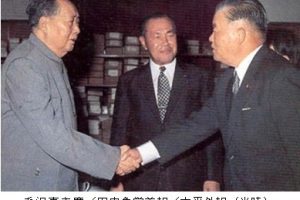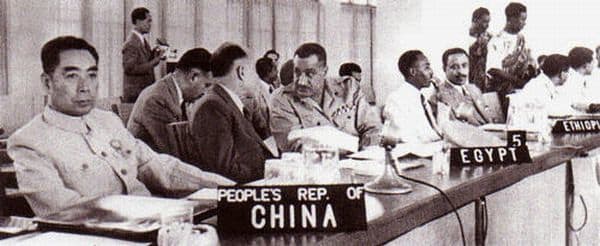Japan's defense white paper this year is even more fueled by Chinese hegemonism and threats. There is a rampant sense of crisis on SNS that Japan will become a vassal state of China if it is not prepared to fight. In the 1990s, concerns began to be raised about the rise of China, and in the 2000s, "expanding China" became unacceptable. The U.S. and British media exaggerate the multilateral dispute over China's territorial claims in the South China Sea, which stems from the suppression of human rights by Chinese authorities in Xinjiang Uyghur, Tibet, and Hong Kong, and the refusal of U.S. forces to approach China's coast, and excessively demonizes China. handled. Then, in 2010, the Japanese government canceled the agreement to shelve the sovereignty over the  Senkaku Islands, which had been a symbol of friendship between Japan and China during Prime Minister Kakuei Tanaka's visit to China in 1972 (photograph), and proceeded to nationalize the Senkaku Islands, making China its "enemy." . America is behind it. For the past 30 years, the United States and Britain have been propaganda about Chinaphobia with the "world's strongest" media, and their brainwashing activities have been most successful in Japan.
Senkaku Islands, which had been a symbol of friendship between Japan and China during Prime Minister Kakuei Tanaka's visit to China in 1972 (photograph), and proceeded to nationalize the Senkaku Islands, making China its "enemy." . America is behind it. For the past 30 years, the United States and Britain have been propaganda about Chinaphobia with the "world's strongest" media, and their brainwashing activities have been most successful in Japan.
■ The real picture of China's reform and opening-up policy
Everyone now agrees that China has shattered US unilateral hegemony. But what is most lacking in today's view of China is that it was the United States that helped rebuild China, which was devastated by the Cultural Revolution. The reform and opening policy advocated by Deng Xiaoping was under the influence of Milton Friedman, the leader of the Chicago School, who strongly advocated economic liberalism. Deng Xiaoping's famous slogans "white cats, black cats" and "rich first" are the slogans that symbolize China's transition to a market-oriented economy. Giant corporations in the United States, Europe, and Japan have created a frenzied investment boom in China by calling the underdeveloped, low-wage China "the world's factory," and amassing enormous wealth.
China, on the other hand, has also acted resolutely. The Sino-Japanese Treaty of Peace and Friendship renounces wartime reparations from Japan. Instead, China accepted investment conditions that were advantageous to China, such as a huge amount of Official Development Assistance (ODA), intellectual property rights, and shareholding ratios. . Behind the scenes, people involved in major Japanese manufacturers and giant trading companies expressed their dislike of China, saying, ``Since they didn't pay reparations, the Chinese people can do whatever they want.'' However, the amount of compensation was astronomical, and it was impossible to pay in the first place. Japanese companies as well as US and European companies competed to invest in China, which has a population of 1.4 billion, as "the world's most attractive market." Not only did the United States enter the Chinese market, but it also provided financial and technical support to China's naval modernization plan in the early 1980s.
In the early 2000s, China, which rose to prominence and continued to expand, was seen as a threat. This in turn was to give business opportunities to US military companies and the military-industrial complex. He tried to move Taiwan and Japan, which were "threatened by China," to the formation of a siege network against China and the expansion of armaments in Australia and Southeast Asian countries, and sold expensive US-made weapons at asking prices. As seen in Japan's defense ministry corruption, so-called defense interests prevailed in the industry of the US allies. In the 2000s, Japan-Australia and Japan-India bilateral security declarations, Britain, France, and Germany's expansion into the Western Pacific, Japan's entry into the globalized North Atlantic Treaty Organization (NATO), Britain's quasi-ally Japan's nationalization of the Senkaku Islands and the dramatic rise in tensions between Japan and China should be seen in this vein.
■The emergence of Xi Jinping and the revival of “common wealth”
Xi Jinping's advocacy of "common prosperity" is a modification of Deng Xiaoping's neo-liberal line. Since 1990, after Deng Xiaoping advocated the theory of wealth first, China achieved high economic growth exceeding double digits per year. According to a survey by a U.S. consulting firm, the number of ultra-rich Chinese households with assets of $1 million or more increased to about 2.4 million in 2013. In 1990, the number of the middle class was around 10 million, but in 2010 it exceeded 600 million. The challenge for the future is to deal with the low-income group, which is about half of the people who are still left behind.
“Common prosperity” is a policy originally proposed by Mao Zedong. In pre-Cultural Revolution China, there was no accumulation of wealth to distribute fairly, and Deng Xiaoping proposed the introduction of a market economy. Mao Zedong criticized Deng Xiaoping as a "reactionary element trying to revive capitalism" and overthrew him. With the resurrection of Deng after the death of Mao, China achieved an unprecedented accumulation of wealth. It was Xi Jinping who came out to review the distribution of wealth.
2021 years. At the 10th meeting of the Central Finance and Economic Commission, Xi Jinping elaborated on joint wealth. “Common prosperity is an essential requirement of socialism and a key feature of the modernization of the Chinese model. It means being rich. It is not the uneven distribution of wealth for the minority, nor the uniform distribution of equality,” he said. In addition, Xi Jinping stated that by the middle of this century, all people will basically realize prosperity together, and that the gap between the income of the residents and the actual level of consumption will be reduced to a reasonable range. Ta.
China is facing a major turning point, advocating socialist modernization as described above. The “China threat theory” should be observed more calmly. For example, in 2019, the countries of Southeast Asia announced their own initiative, the "ASEAN Outlook on the Indo-Pacific," as an alternative to the "Indo-Pacific Initiative," a network encircling China centered on the United States, Britain, Japan, and Australia. “We are aiming for an Indo-Pacific region of dialogue and cooperation, not competition,” calmly restraining the US, UK, Japan, and Australia from viewing China as hostile and agitating. For the Association of Southeast Asian Nations (ASEAN), China is the largest trade and investment partner, and building a mutually beneficial relationship with the neighboring giant, China, is essential for economic development. Even though five of the ten member countries have serious territorial disputes with China in the South China Sea, China is not an enemy, but a partner for coexistence and co-prosperity. No country is afraid of being made a vassal state of China.
Many Japanese people cannot get rid of their admiration and complex about "the center of the world, the United States, Britain and France", and are stuck in the contempt of "behind Asia and Africa". As I have repeatedly pointed out in this blog, the Japanese view of China in particular is distorted by its long history. Note: Nevertheless, it goes without saying that it is possible to coexist beyond the political system with China, where the Xi Jinping leadership has launched the slogan of "a powerful modern socialist country." Now not only Southeast Asian nations, but India, Pakistan, Central Asia, the Middle East, Africa and Latin America, an overwhelming number of Global South nations have left the United States and joined hands with China.
Note: Reference article 2023/05/31 Overcoming the hostility toward China that has bound the Japanese since ancient times for the improvement of Japan-China relations and the settlement of the pre-war regime
■ Ideas of the Bandung Conference and the Rise of AA Countries
Russia is cooperating with China under the leadership of the former Third World Group. On July 28, the Russia-Africa Conference issued a summit declaration in St. Petersburg stating that they had agreed to seek compensation for damages caused by colonialism against the United States and European countries. This can be said to be the result of the solidarity of the Asian-African (AA) countries that have progressed non-alignedly since the 1955 Bandung Conference (photograph). Syria's return to the Arab League and reconciliation between Iran and Saudi Arabia are symbols of trust in China. The G77 issued a statement in hopes that the SCO would create a new international order to replace the United Nations, in light of the fact that many countries are joining the Shanghai Cooperation Organization (SCO) led by China and Russia. In Shanghai, a New Development Bank (BRICS Bank) was established to replace the International Monetary Fund (IMF), one of the pillars of the US postwar order Pax Americana, and a BRICS currency convertible to gold is being considered. Arab Middle East countries such as Saudi Arabia, the largest oil producer, and Central and South American countries such as Venezuela, a major oil producer, are cooperating with this, accelerating the collapse of the petrodollar and the decline of the key currency, the US dollar.
Even if the other country does not accept Chinese-style socialism, China will allow subversive organizations to support anti-government forces camouflaged by civic groups and non-profit corporations, as in the United States, under the name of "democratization." Overthrow = do not attempt to change the system. The “democratized” pro-American regime is deprived of sovereignty, especially diplomatic freedom, as a dependent state bound by Washington. The Potsdam Declaration of August 1945, which advocated the democratization of Japan, was in a different form, but intended to place Japan semi-permanently under servitude to the United States and Great Britain. The aims of the United States and the United Kingdom were embodied in the form of the Japan-U.S. Security Arrangements. The reason why the United States has put up a strong ``defeated neck'' of the Japan-U.S. Security Treaty is that there is a definitive distrust of Japan, as can be seen in Dulles' statement below. However, if you wear a collar and control it, there is no "economic power and technological power" that is as easy to use as Japan. What Japan should do now is to abandon the idea of being a great power, become independent from the United States, transform itself into a republic, and through that, achieve true reconciliation with the AA nations.
■ Semi-permanent Japan heterogeneity theory and distrust of Japan
The government of Fumio Kishida is trying to achieve the goal of turning Japan into a military superpower under the control of the United States, which was initiated by the Shinzo Abe government. The U.S. neoconservatives have revived the Abe administration in 2012 as a hegemonic power and military power in Asia that “want to regain Japan,” and are trying to make the most of it to contain China. The Abe Group believes that (1) revision of the Japanese constitution is an urgent issue in order to counter a huge neighboring country that might invade Japan, and (2) Japan should become a "normal country" with a national defense force capable of collective self-defense and strict protection of state secrets. (3) Expand defense spending, improve military technology, and nurture Japan's defense-related industries. This was largely accomplished, and the Kishida government came into power.
For the second Abe administration, whose slogans are “breaking away from the post-war regime” and “regaining a strong Japan,” the “nationalization of the Senkaku Islands (Chinese: Diaoyu Islands)” by the DPJ administration was a stroke of luck. This is because, in contrast, the threat from China, which strongly asserts its sovereignty over the Senkaku Islands and escalates its actions, has decisively planted the “China threat” in the hearts of the Japanese people. This threat presented a once-in-a-lifetime chance to Japan's ultranationalists, who had worked hard to create a pretext for post-war Japan's regime change, the hollowing out of Article 9 of the Constitution. While controlling the Abe administration and the right-wing forces surrounding it, the United States and Britain skillfully handled their military aspirations and great power orientation. Nonetheless, at the core of the Abe faction was the anti-U.S. far-right ideology of denial of the Tokyo trial and denial of the U.S. occupation policy. They waited for an opportunity to cut.
Before the war, especially during the war, Nobuaki Makino, Aisuke Kabayama, Kijuro Shidehara, Shigeru Yoshida, and Tsuneo Matsudaira, who were in favor of Britain and the United States, were the source. Kishida, a descendant of the conservative mainstream Hiroike-kai personal network whose ancestor was Hayato Ikeda, who advocated "priority route", was a suitable person for the post-Abe post-Abe neoconservatives. The lightly armed line was replaced by the large-scale military expansion line, but Kishida, the leader of the weak fourth faction, the Kochikai, was given power because it was a group that Washington could operate with peace of mind. The Cabinet approved the exercise of the right to collective self-defense through constitutional revision, which almost 100% of constitutional scholars considered unconstitutional, and the new security legislation came into effect. It will be achieved. In fact, at the end of 2015, Abe told Soichiro Tahara that he no longer needed to revise the constitution. It was impossible for the Kishida group, which was restrained by constitutional revision, to gather the energy to achieve the de facto ``revision of Article 9''.
In the latter half of the 1980s, during Japan's bubble period, Washington's thorough bashing of Japan (Japan bashing) and Japan's heterogeneity theory were paraphrases of the American, British, Anglo-Saxon's irrepressible distrust of modern Japan after the Meiji period. Dulles' true intentions clearly show this. Unless we are freed from the far-right ideology that insists on denying the Tokyo trial and denying the US occupation policy, distrust of Japan and becoming a vassal state of Japan will continue semi-permanently.
■ Brainwashing tactics that take advantage of an insurmountable wall
The battle over Ukraine is a breakthrough for the United States, Britain, and Anglo-Saxons to break up China and Russia and conquer Eurasia. Without this perspective, it is impossible to see through the movements of the modern world. They are trapped in a fantasy that ``after the dissolution of Russia, communist China will go bankrupt''. Amidst a remarkable shift away from the United States, the Global South became a torrent of movement toward full-fledged independence from the former colonial powers and Western countries, with China at the core. I do not believe that the G7 (the United States, Europe, and Japan) has the power to stop this. The threat of China was created by the United States and Britain.``The Belt and Road Initiative, which covers Eurasia and extends to Africa, Central and South America, is a symbol of China's neo-colonialism, which traps recipient countries in a debt trap and seeks to acquire concessions.'' and build a military base.” “China rounded up the five former Soviet bloc countries, which are the core of Eurasia, and headed for confrontation with Russia. The weaknesses of Russia and the Global South lie in their soft power: the democratic institutions won internally by the United States and Europe through modern civil revolutions, the sophisticated culture of architecture, art, and music inspired by the Renaissance, and the colonial rule of the outside world. The enormous wealth gained through slaughter and plunder in WWII is incompatible with the suffering of the AA countries.
Many leaders of the Global South believe that globalism, neo-liberalism, hegemonism and military intervention, which replace the former colonialism of the United States and Britain, do not lead to the happiness of the people of the world, but rather to the source of unhappiness. There should be On the other hand, while the United States and Europe inside and outside are contradictory, the number of foreign students studying in the United States is overwhelmingly dominated by Chinese students. It has become an insurmountable wall.
The Chinese phobia of the Japanese is the result of brainwashing by the United States and Britain, which took advantage of this insurmountable wall. As I have repeatedly quoted, I will paste the words of US Secretary of State John F. Dulles (pictured right, then  President Eisenhower (left)) who wrote about the conclusion of the San Francisco Peace Treaty and the Japan-U.S. Security Treaty. If you take this into account and observe the current situation in Japan, you can immediately understand that the Chinese phobia of the Japanese is a product of the United States and Britain, who are afraid of China.
President Eisenhower (left)) who wrote about the conclusion of the San Francisco Peace Treaty and the Japan-U.S. Security Treaty. If you take this into account and observe the current situation in Japan, you can immediately understand that the Chinese phobia of the Japanese is a product of the United States and Britain, who are afraid of China.
"The sense of superiority that the Japanese often had over China and other Asian nations, and joining the Western camp of the 'elite Anglo-Saxon club' against communist nations, such as the United States and Great Britain, We should use the fulfillment of this yearning to keep loyalty to the Western camp, and the dilemma of rearming Japan and incorporating them into the Western camp, and on the other hand, not being able to trust the Japanese. The solution was to build a Japan-U.S. Security Alliance that would permanently subordinate Japan militarily to the United States."
